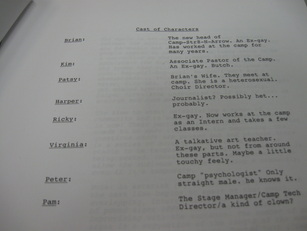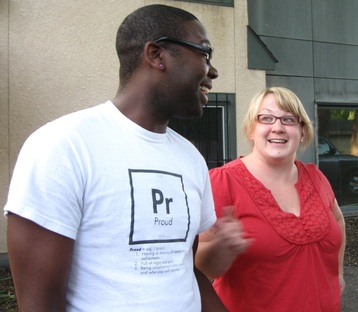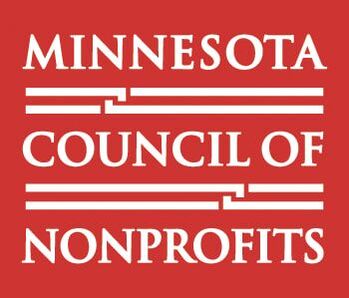|
This week's blogger, Eric F. Avery, talking about the genesis of Ex-Gays. Recently, I lost my iPod on the way to the airport. Yes, I'm dumb; I'm over it. On the device I kept music, checked my e-mail, managed my calendar, and countless other little tasks that people use their digital buddies for. With all of that: I can do without or find a new way. What's irreplaceable for me are ideas I had recorded for new works: Plays, concepts, images, characters, scenarios, structures, etc. Anytime I get an idea from my experience in the world I write it down. Simple. Early on in my training at the University of Kansas a professor told me that a theatre artist should always have 6 ideas for projects they want to do ready at all times. Why 6? I know not. These projects may develop while in waiting, come, go, combine, or actually find a way to production. Ex-Gays entered my project cue sometime in 2009 when two tracks for possible projects collided.  For years I have been wanting to create a character in the style of Revered Billy, ever since I took a short workshop with him in 2004. My primary interests in that were exploring religion, as well as creating a character driven piece that would interact directly with the audience. The other track was wanting to respond to a piece I heard on This American Life called "81 Words," about the journey of getting homosexuality removed from DSM. Eventually, I had the idea to make a character involved with the Ex-Gay movement as it would address feelings of those who opposed the DSM change, have a religious component, and provide many examples of possible structures for audience interaction. So with my initial idea intact I began to work on the character Pastor Brian. I began to find his voice, his physicality, his story, and not just in my imagination. I would improvise as Brian by myself, with friends, on the phone, and even occasionally with strangers. Quite soon after he started making sense to me I decided that a two person show would be the best fit, and after a series of conversations with trusted collaborator Laura Leffler-McCabe we set a workshop date for April 2010.  Developing new works is one of those areas in art where there are shared values with science. There are tried and true recipes and formulas to create, but to truly innovate one has to set into a laboratory and experiment. We rehearsed the show over the course of a week and put together a 40 minute workshop for a very modest audience of colleagues. It was time for me to return to Baltimore, so Laura and I took our data and began to analyze what we had done in April and what the next step was. Was the hypothesis valid? Have our initial calculations been on the mark? Should we return to the drawing board? The next part happened of the course a a few months, so for the sake of time I'll write a short play about what it was like. Laura: Eric, we are a growing company. I think we should have other people play these parts. Eric: But other people smell funny. Why can't we do it all? Like Barbara Streisand. Laura: You don't have the bone structure. Also, the piece will make more sense with more people, and we're going to have all of these fabulous new company members joining soon. Eric: Okay. I guess that makes sense. I’ll write; you direct? Laura: Maybe one of us should be it in... Eric: Okay. You. Laura: No, you. Eric: NO, you! Laura: Neither? Eric: Deal. See ya this summer! ….and here we are. A company of artists entering into the rehearsal process to discover a new work. It's exciting, terrifying, and all of those things that make art and life worth doing. To answer you initial question, Bobby, ideas come from everything. Always. It’s simply a matter of perceiving the world in a way that it inspires one to create. So put down your iPod. Carefully. And go experiment the world. Comments are closed.
|
Archives
November 2020
|

 RSS Feed
RSS Feed




